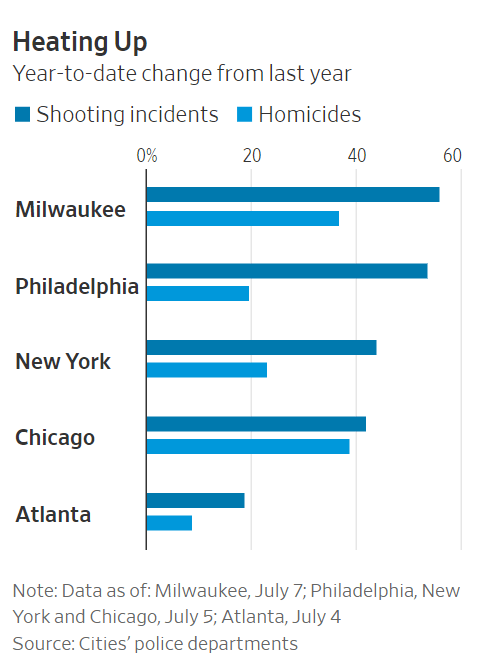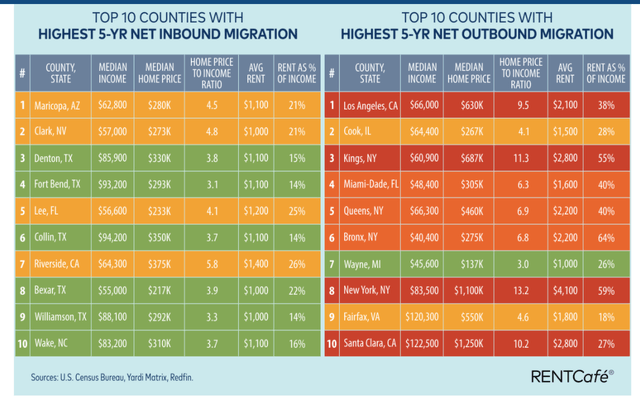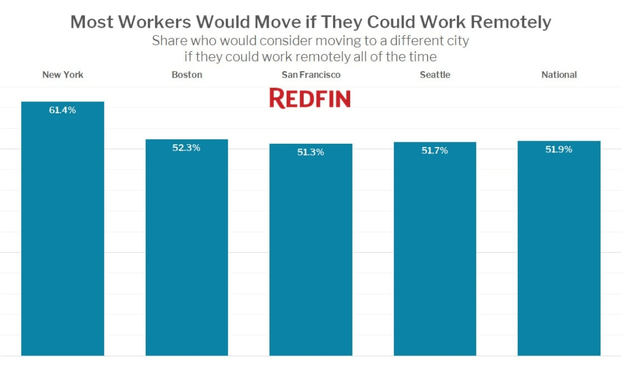What was a major reason for Americans to move to the Sunbelt?
Thesis
Pre-COVID-xix economic and demographic trends will exist accentuated past COVID-nineteen. Prior to COVID-xix, cities were losing population to the suburbs and smaller metros. Greater economic decline from COVID-nineteen shutdowns, ascent violent criminal offense, housing unaffordability, and shift to remote piece of work will initiate a sunbelt and suburban benefaction. To use a phrase by the tardily great Ross Perot, the urban cadre will experience a behemothic sucking audio of people fleeing for more than affordable, warmer, and lower taxed metros beyond the country.
Decline of Gateway Cities
Gateway cities will experience a significant decline in relative size and economic power due to a variety of trends that are in the early stages.
Economical Decline
COVID-19 infection rate and economic decline are two correlated dynamics. Regions of the country that were initially more affected by COVID-19 instituted significant lockdowns that have had severely negative economical effects.
Metro Marketplace Type July Unemployment rate National - 10.twenty% NYC Primary xvi.twoscore% LA Main 16.80% Boston Primary 15.50% SF Main xi.10% Chicago Primary 12% Salt Lake City Secondary 5.xxx% Dallas Secondary 7.50% Austin Secondary 6.seventy% Raleigh Secondary eight.00% Atlanta Secondary 8.l% Charlotte Secondary nine.30%
Source- Agency of Labor and Statistics
The degree to which population density contributed to COVID-nineteen infection is still up for debate. However, it is indisputable that larger, densely populated metros were field of study to much stricter lockdowns, which contributed to significantly less economic and social action. Apple mobility trends have comprehensive data to demonstrate only how stark the divergence in mobility rates was among metros across the state.
As the economy recovers from the recession, major urban metros lag behind. A contempo Moody's report forecasted a quicker recovery for metro areas less densely-populated and with high levels of educational attainment. This will benefit many of the smaller metros listed above with low unemployment rates.
The economic impact will be severe for gateway cities. Cities project massive budget deficits due to revenue decreases caused by lower economic activity. High budget shortfalls could result in municipal tax increases or a reduction in services, both of which will diminish the bewitchery of urban life.
Rising Violent Crime
Months of lockdowns, high levels of unemployment, and social unrest have created a perfect storm for the recent spike of violent crime. The rise is a short-term reversal of the decades-long pass up in tearing crime experienced by cities since the 1990s, which was a major allure to urban areas.

Source
While there is a vast array of theories with respect to why violent crime has declined, the 1990s coincided with a period of increased policing. In contrast, calls today include to defund police departments, despite the massive increases in violent criminal offense. Some cities have already acted on these calls. New York City and Los Angeles cut police funding by $1 billion and $150 million, respectively.
I volition non speculate on whether defunding police departments will alleviate or worsen the spike in vehement criminal offense for cities. However, public stance polls show significant unpopularity for the motion. Just 34% of Americans have a favorable view of the defund the constabulary movement, while but 53% oppose it. Consequently, rises in violent crime coinciding with further cuts to law services could certainly contribute to a higher charge per unit of migration out of cities.
Housing Unaffordability
One of the unfortunate staples of living in a metropolis is the loftier cost of housing compared to secondary and tertiary markets. The tiptop 10 counties with the highest levels of in-migration comprise many prominent secondary and 3rd markets in the sunbelt. This contrasts with the top 10 counties with the highest levels of internet out-migration, which are heavily in main markets.

Housing is approximately twice as affordable in the top in-migration markets compared to the summit-out migration markets. The average rent in the top in-migration counties is $i,110, while the average rent in the top out-migration counties is $2,207.
Aside from average rents, rent-to-income ratios also demonstrate well-nigh secondary and third markets are much more affordable than their primary market peers.
Market Market blazon Rent-to-income five-yr population growth projected NYC (Manhattan) Primary 51% 0.10% LA Primary 32.50% 0.30% Chicago Primary 22.thirty% 0.10% DC Primary 29.50% 0.80% Phoenix Secondary 19.xx% 1.50% Dallas-Fort Worth Secondary 18.xx% i.sixty% San Antonio Secondary xviii.30% i.60% Raleigh Secondary twenty% 1.30%
Source
Minor Metros Rise Upwardly
It is important to recognize that this information is backward looking. The higher cost of urban housing existed pre-COVID-19. Even then, information technology was cited as one of the leading causes of in-migration to more than affordable markets. The U.S. Census Bureau reported 55% of those who decided to move did so for cheaper housing.
On a frontwards-looking footing, non but are these trends set to continue, only multiple early signs bear witness they are accelerating. Data from the US Postal Service demonstrates significant increases in post-forwarding from NYC to alternative suburbs or metropolitan areas. While the Mail service typically received merely over 20,000 requests each month, 56,000 requests were received in March and 81,000 in April. Such indicates people are already fleeing urban areas.
Post-forwarding may betoken short-term move-outs, as New Yorkers could be escaping for a few months and planning to return. Yet, there have also been ominous long-term signs for population trends in big cities. Redfin data showed a surge in interest in secondary and tertiary markets. Unsurprisingly, the rising interest came from people already residing in primary markets, such every bit Los Angeles, New York City, and San Francisco. A plurality of respondents listed cost as their chief motivator for seeking to movement elsewhere.
Surveys also showed that more than 50% of Redfin users would consider moving if their piece of work shifted to fully remote.

Source
Often, people are tied to a item city because it is where they work. Major employers have already appear they volition be allowing greater employee flexibility in terms of working in the office. Twitter (TWTR), Facebook (FB), and Shopify (SHOP) appear they would be giving employees the pick to work from home. Exterior of tech, Morgan Stanley announced they would be reducing their real manor footprint. Concrete office space in urban cores will be less necessary for a growing share of the workforce due to remote work. Greater work from home will incentivize more than people to consider moving to more than affordable metros.
Lastly, many of the sunbelt metros where people are migrating to accept much warmer climates than the densely-populated Northeast. I recollect this is an overlooked reason for the sunbelt smash, equally the highly-seasoned climate is a constant feature of the region. Changes in economic prospects will not alter the cute weather of the sunbelt metro areas. As standards of living have increased, the valuation of overnice weather as a consumption amenity has increased as well. With people having greater means and resources to movement warm climates, they are doing merely that by moving to the sunbelt.
The Metropolis is Expressionless
Strict lockdowns, economic decline, spikes in violent crime coinciding with an unpopular push to defund police departments, housing affordability concerns, and an impending shift to remote work have created a perfect storm to usher a moving ridge of migration from America's urban core to less densely-populated, smaller metros. Americans have long preferred life exterior the city. A 2018 Gallup survey showed that while fourscore% of the US population lives in urban areas, rural life is almost desired. Greater growth in remote work is making that a realistic possibility for millions of Americans. If work can exist done outside a major urban middle remotely, many urban residents will be gratuitous to relocate to lower price, more bonny locations. Long term, gateway cities will experience a decline in their relative power as a effect.
I will encompass solid investment opportunities that are positioned to benefit from the coming urban cadre to sunbelt neat migration trend in my next article.
This article was written past
Build sustainable portfolio income with premium dividend yields upwardly to 10%.
Alex Mansour is an undergraduate college pupil. Writing for Seeking Alpha since 2019, I cover primarily the disinterestedness existent estate investment trust (REITs) infinite. I invest across all sectors of existent estate, focusing on companies with potent earnings growth and trading at discounts to fair value. Relative to other analysts, my coverage emphasizes smaller and underfollowed companies that receive less attention from the mainstream, resulting in discounted valuations. While a long-term investor, I will recycle majuscule from companies that have reached or exceeded their off-white value into more undervalued companies.
Subscribe to my free newsletter on substack: https://dividendstocks.substack.com/publish
Promoting Contributor for Hoya Capital letter Income Builder.
Disclosure: I/we take no positions in any stocks mentioned, and no plans to initiate whatsoever positions within the adjacent 72 hours. I wrote this article myself, and it expresses my own opinions. I am not receiving compensation for it (other than from Seeking Alpha). I have no business organisation human relationship with whatsoever visitor whose stock is mentioned in this article.
Source: https://seekingalpha.com/article/4373053-giant-sucking-sound-of-migration-from-urban-core-to-sunbelt
0 Response to "What was a major reason for Americans to move to the Sunbelt?"
Post a Comment